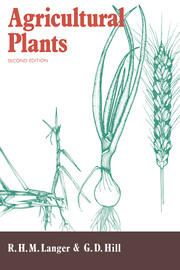Book contents
- Frontmatter
- Contents
- Preface to the first edition
- Preface to the second edition
- 1 World population and crop production
- 2 Plant structure
- 3 Liliaceae
- 4 Poaceae
- 5 Apiaceae
- 6 Asteraceae
- 7 Brassicaceae
- 8 Cannabinaceae
- 9 Chenopodiaceae
- 10 Cucurbitaceae
- 11 Fabaceae
- 12 Lamiaceae
- 13 Linaceae
- 14 Malvaceae
- 15 Papaveraceae
- 16 Solanaceae
- 17 Physiological basis of yield
- Index of specific names
- Subject index
13 - Linaceae
Published online by Cambridge University Press: 05 June 2012
- Frontmatter
- Contents
- Preface to the first edition
- Preface to the second edition
- 1 World population and crop production
- 2 Plant structure
- 3 Liliaceae
- 4 Poaceae
- 5 Apiaceae
- 6 Asteraceae
- 7 Brassicaceae
- 8 Cannabinaceae
- 9 Chenopodiaceae
- 10 Cucurbitaceae
- 11 Fabaceae
- 12 Lamiaceae
- 13 Linaceae
- 14 Malvaceae
- 15 Papaveraceae
- 16 Solanaceae
- 17 Physiological basis of yield
- Index of specific names
- Subject index
Summary
The Linaceae are a small family comprising only about 150 species, of which only one, Linum usitatissimum is of agricultural importance. This crop is grown either for its fibre, linen flax, or for its oily seed, depending on the cultivar used and the cultural and climatic conditions. The taller linen flax is grown in cool, temperate regions, more than one-half of it in the USSR and much of the remainder in Northern Ireland, Belgium and other northern and east European countries. The shorter and more quickly maturing linseed prefers warmer climates and is cultivated in parts of South America and the USA, Canada, India, and the USSR.
LINSEED AND FLAX (LINUM USITATISSIMUM)
The cultivation of linen flax goes back to the dawn of civilisation, as shown by the remains of the prehistoric Swiss lake dwellers. The ancient Egyptians had a high regard for linen, and they used it not only for clothing but also for the wrapping of mummies. They also embalmed bodies with linseed oil. The Greeks and Romans also relied extensively on linen, as shown in the writings of many classical authors, and the crop is also mentioned in the Bible. In Asia, notably in India, linseed oil played a part in religious rituals, and in fact there are strong indications that at least the fibre type of Linum originated there and that it spread northward and westward over the centuries.
- Type
- Chapter
- Information
- Agricultural Plants , pp. 293 - 298Publisher: Cambridge University PressPrint publication year: 1991

